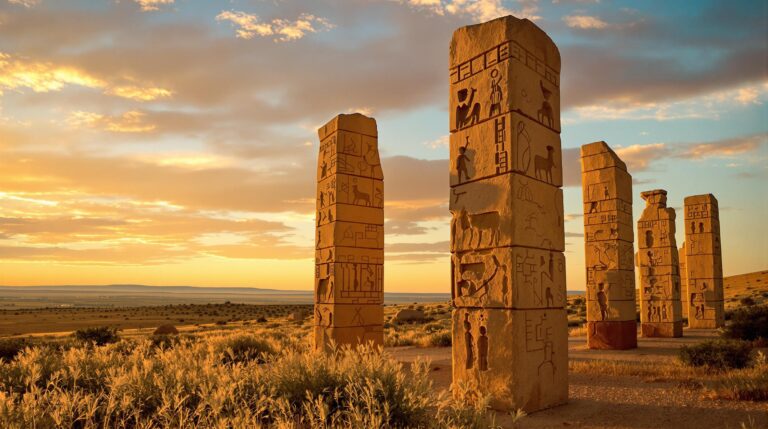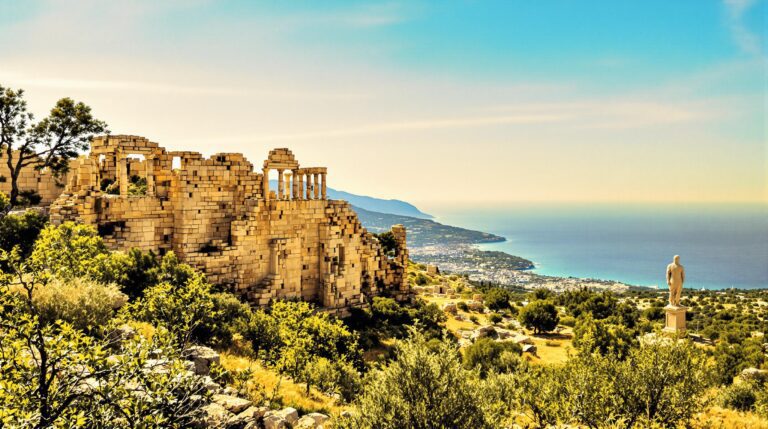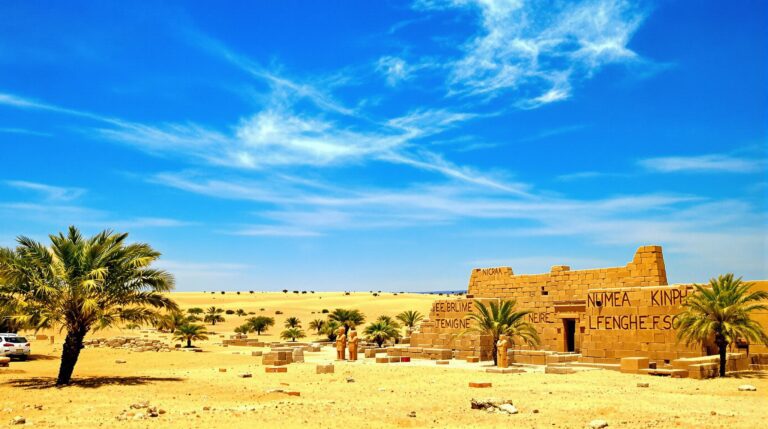Ancient Crete: Rituals, Myths, and Power
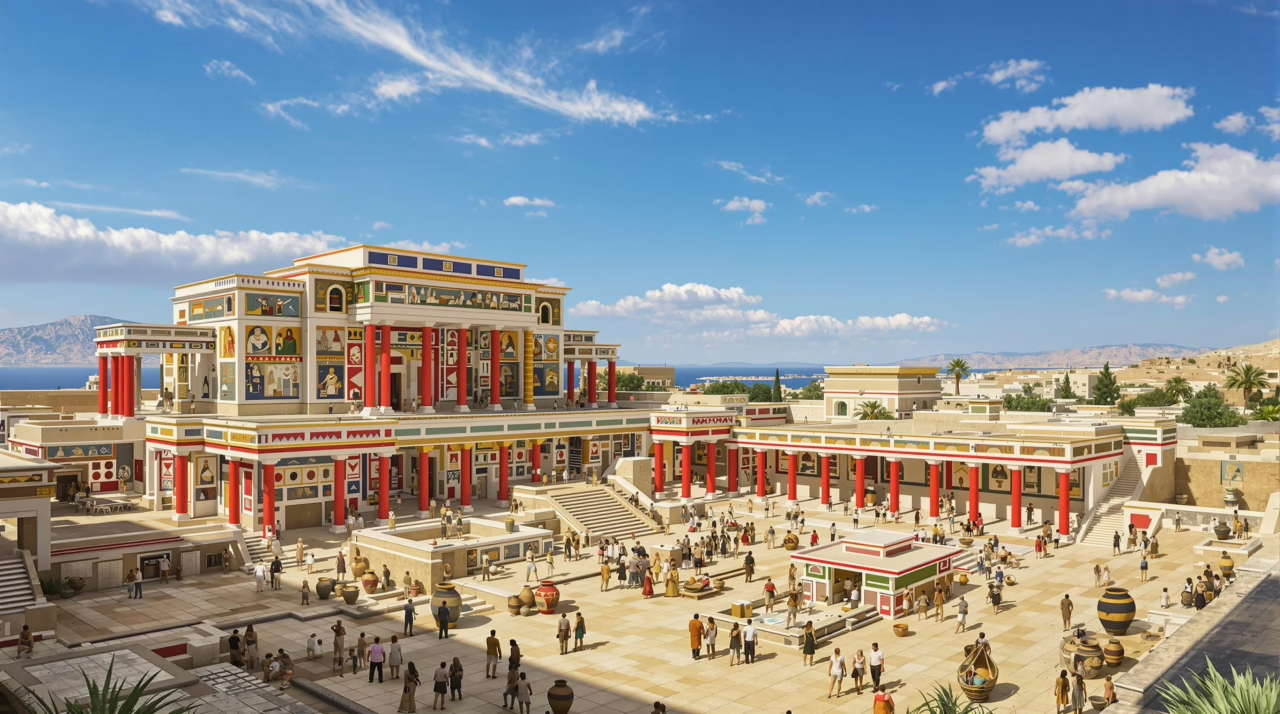
Ancient Crete emerged as a civilization rich in ritual and myth, where the bull’s image surged through art and worship.
Labyrinths twisted through palatial complexes, embodying chaos and order.
Priestesses wielded spiritual authority, steering the currents of power in a society that revered nature’s forces. As these elements intertwined, they shaped a culture that would echo through time.
Yet, the intricate relationship between their beliefs and societal structures invites further exploration into their enduring legacy.
Key Takeaways
Hide- Minoan rituals were deeply intertwined with art and symbolism, using bull imagery to represent fertility and strength in religious practices.
- The labyrinth and Minotaur myth captured chaos and duality, reflecting the complexity of Minoan cultural narratives and societal experiences.
- Priestesses played crucial roles in spiritual practices, embodying sacred authority through ceremonial garb and guiding community worship at shrines and caves.
- The undeciphered Linear A script hints at the administrative and religious complexities of Minoan society, while Linear B provides insights into governance and trade.
- Minoan craftsmanship, especially in jewelry and pottery, symbolized social hierarchies, distinguishing elites from citizens in daily life and power dynamics.
The Rise of the Minoan Civilization in Ancient Crete
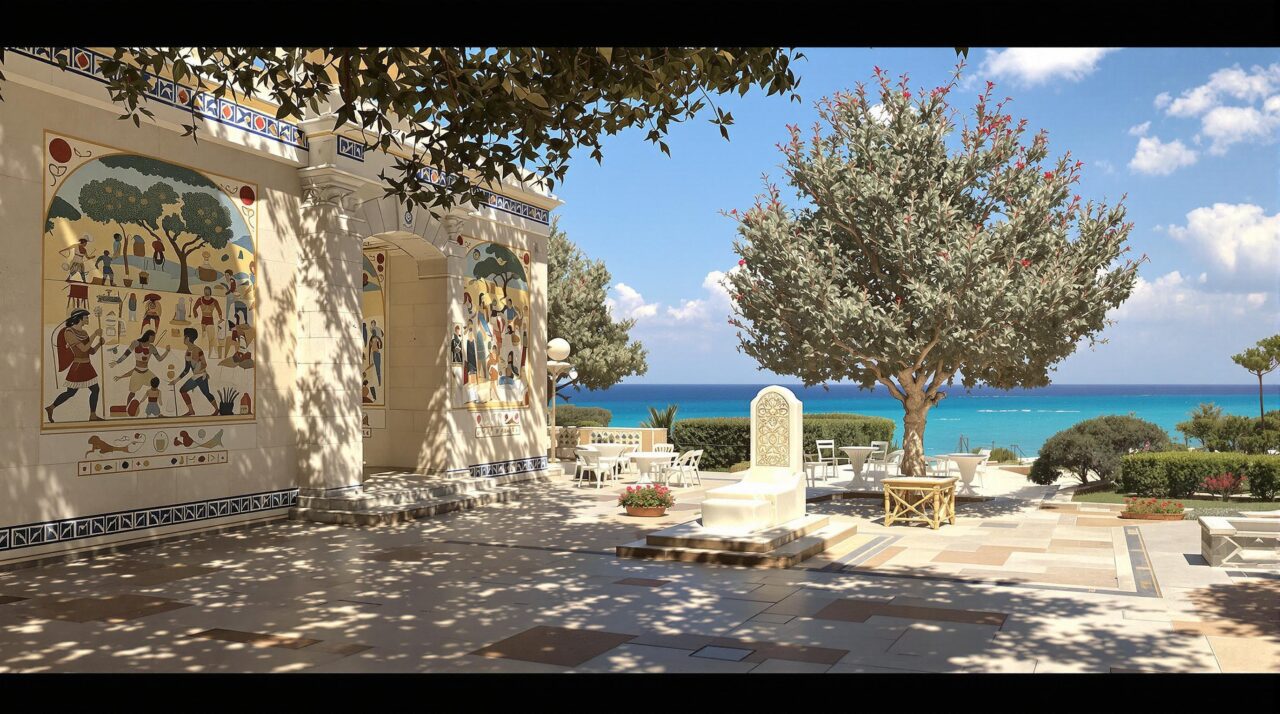
The Minoan civilization emerged as a beacon of innovation in the heart of the Aegean, propelled by a network of early settlements that thrived on maritime trade.
These communities, with their intricate palace centers and sophisticated urban planning, transformed the landscape of Crete into a lively tapestry of culture and commerce.
Through this interplay of sea and society, the Minoans crafted a legacy that would echo through the annals of history.
Early Settlements and Maritime Expansion
Nestled at the crossroads of Europe, Asia, and Africa, ancient Crete emerged as a lively hub of maritime activity, its shores kissed by the waves of trade.
The Minoan civilization flourished through strategic connections with distant lands, particularly Egypt and the Levant, weaving a tapestry of cultural exchange and economic prosperity.
This early settlement not only showcased the ingenuity of its people but also heralded an era where the sea was both a lifeline and a bridge to a world teeming with possibility.
Strategic location between Europe, Asia, and Africa
Positioned at the crossroads of Europe, Asia, and Africa, Ancient Crete served as an essential conduit for trade and cultural exchange, shaping the rise of the Minoan civilization.
Its strategic location fostered:
- Diverse cultural interactions that enriched Minoan society.
- Maritime prowess, enabling control of crucial sea routes.
- Economic prosperity through the exchange of goods and ideas.
Trade connections with Egypt and the Levant
While the Minoans thrived in their island sanctuary, their trade connections with Egypt and the Levant emerged as pivotal catalysts for their civilization’s growth.
These maritime routes facilitated the exchange of goods, ideas, and cultural practices, weaving a vibrant fabric of influence.
Luxurious textiles, precious metals, and exotic goods flowed into Crete, fueling innovation and reinforcing the Minoans’ status as a dominant maritime power.
Palace Centers and Urban Planning
In the heart of the Minoan civilization, sprawling palace centers like Knossos and Phaistos emerged as architectural marvels, embodying both power and artistry.
Central courts, surrounded by storerooms and adorned with lively wall art, served as the dynamic hubs of social and economic life, reflecting a society that thrived on complexity and innovation.
- Göbekli Tepe Mystery: Ancient Site Redefines History
- Harappan Civilization: Inside the Planned Cities of the Indus Valley
- Ancient Nubia: The Forgotten Kingdom
- Sumerian Secrets: The Birthplace of Ancient Innovations
- Ancient Persia: Golden Age and the Achaemenid Legacy
- Lost Glory of the Nubian Kingdom of Kush
The urban planning of these sites reveals not just a functional layout, but a profound connection to the rituals and myths that defined this ancient culture.
Knossos, Phaistos, and other complex sites
As the sun cast golden hues across the rugged landscape of Crete, the sophisticated palatial complexes of Knossos and Phaistos emerged as monumental symbols of the ingenuity of the Minoan civilization.
These sites showcased:
- Advanced architectural designs, illustrating urban sophistication.
- Complex social hierarchies, indicated by spatial organization.
- Cultural vibrancy, reflected in artifacts and ceremonial spaces.
Together, they reveal the essence of Minoan life and governance.
Central courts, storerooms, and vibrant wall art
Central to the Minoan civilization’s architectural genius are the expansive central courts, intricately designed storerooms, and the dynamic wall art that adorned their palatial complexes.
These spaces served as lively hubs of social interaction and economic exchange, while the vivid frescoes narrated tales of nature, ritual, and power, reflecting a society deeply connected to its environment and the mythic narratives that shaped its identity.
Art, Symbolism, and Religious Practice
In ancient Crete, the interplay of art and symbolism served as a conduit for profound religious expression, where the bull emerged as a potent emblem of fertility and strength within sacred rituals.
Priestesses and religious elites wielded significant influence, guiding these spiritual practices through the labyrinthine complexities of belief, as mythical narratives intertwined with the tangible world.
The enigmatic figures of labyrinths and Minotaurs not only captivated the imagination but also reflected deeper societal values and fears, resonating within the collective psyche of the Minoan civilization.
Bull Imagery and Sacred Rituals
In the lively frescoes of ancient Crete, the dynamic scenes of bull-leaping emerge as a powerful demonstration to the intertwining of art and ritual, echoing the civilization’s deep reverence for this majestic creature.
These images not only capture the thrill of the daredevil athletes but also resonate with mythological narratives that elevate the bull to a symbol of fertility and strength.
Through intricate sculptures and vivid symbolism, the bull transcends mere representation, embodying the sacred essence of Minoan religious practices and their connection to the divine.
Bull-leaping scenes and mythological associations
While the sun-drenched landscapes of ancient Crete provided a vivid backdrop, it was the ritualistic spectacle of bull-leaping that captivated both participants and spectators alike.
This daring act intertwined with myth, embodying themes of importance and sacrifice, reflected in:
- The Minotaur legend, representing power and chaos.
- Fertility rites, symbolizing agricultural abundance.
- Heroic endeavors, showcasing courage and skill.
Symbols found in frescoes and sculptures
As the lively frescoes and intricate sculptures of ancient Crete reveal, the symbolism surrounding bulls transcended mere artistic representation, intertwining with the very fabric of Minoan religious and cultural identity.
Bulls embodied strength, fertility, and the divine, reflecting the civilization’s reverence for nature’s primal forces. These images served not only as decorative motifs but as profound expressions of the spiritual and communal life of the Minoans.
The Role of Priestesses and Religious Elites
In the labyrinthine landscape of Ancient Crete, priestesses emerged as essential conduits between the divine and the mortal, their ceremonial garb reflecting sacred authority and spiritual connection.
Elegant figurines, adorned in intricate attire, resonate with the vibrancy of ritual life, hinting at the powerful role these women played in the religious tapestry of the island.
Shrines and sacred caves, scattered across the terrain, served not only as physical spaces for worship but also as sanctuaries for the rich mythology that enveloped their practices.
Figurines of women in ceremonial attire
Figurines of women adorned in intricate ceremonial attire serve as enchanting artifacts that illuminate the spiritual and social fabric of ancient Cretan society.
These figures reflect not only artistic mastery but also symbolize the prominence of female figures in rituals. Their significance can be explored through:
- Elaborate headdresses and jewelry.
- Stances indicating ritualistic roles.
- Varied materials reflecting societal values.
These elements reveal deep connections to faith and power.
Shrines and sacred caves across the island
The presence of shrines and sacred caves across ancient Crete underscores a complex interplay of art, symbolism, and religious practice that defined the island’s spiritual landscape.
These hallowed sites served as focal points for ritualistic gatherings, where priestesses wielded their influence.
Enigmatic symbols adorned the walls, inviting contemplation and connection, revealing a society deeply engaged in the mysteries of life, death, and the divine.
Labyrinths, Minotaurs, and Mythical Interpretations
The labyrinth, a complex network of twisting paths, emerges from the shadows of Minoan civilization, symbolizing both the chaos of the human psyche and the divine order that governs it.
Central to this enigmatic structure is the Minotaur, a creature born of human desires and divine retribution, forever trapped within its confines, reflecting the duality of creation and destruction.
As the legend unfurls through the tapestry of Greek mythology, it weaves intricate threads of symbolism, transforming ancient rituals into timeless narratives that resonate with the collective consciousness of humanity.
Origins of the labyrinth legend
While exploring the intricate tapestry of ancient Crete, one encounters the labyrinth legend, a fascinating blend of art, symbolism, and religious practice that transcends mere storytelling.
This mythological narrative reveals deeper meanings through:
- The intricate design of the labyrinth, symbolizing the complexity of life.
- The Minotaur, representing the duality of human nature.
- Rituals surrounding the labyrinth, reflecting societal hierarchies and power dynamics.
Influence on later Greek mythology
As the labyrinth legend wove its way through the fabric of ancient Greek mythology, it left an indelible mark on subsequent narratives, art, and religious practices.
The Minotaur became a symbol of human struggle against chaos, while labyrinthine motifs adorned temples, embodying the quest for knowledge.
These interpretations reflected a society grappling with order, identity, and the profound mysteries of existence, echoing through the ages.
Writing Systems and Lost Languages
In the shadowy corridors of time, the enigmatic scripts of Linear A and Linear B beckon scholars with their promise of untold stories and forgotten truths.
While Linear A remains an undeciphered whisper of Minoan civilization, Linear B offers a glimpse into the Mycenaean adaptation, bridging cultures yet shrouded in mystery.
Together, these writing systems encapsulate a diverse mosaic of language that evokes the complexity of ancient Cretan identity and ritual.
Linear A: The Undeciphered Script
Linear A, the enigmatic script of ancient Crete, has been unearthed in various archaeological sites, hinting at a complex administrative system that remains tantalizingly out of reach.
Its symbols, a cryptic tapestry of sounds and meanings, pose significant challenges for modern scholars, who grapple with the absence of a Rosetta Stone to reveal its secrets.
As researchers sift through the remnants of this lost language, the allure of what Linear A could disclose about Minoan culture continues to captivate the imagination.
Where it has been found and how it was used
The enigmatic script known as Linear A has captivated scholars and archaeologists alike, its symbols etched into clay tablets and pottery shards unearthed primarily on the island of Crete.
These artifacts provide tantalizing glimpses into a society that thrived on ritual and trade, suggesting uses such as:
- Religious offerings
- Administrative records
- Economic transactions
Each discovery deepens the mystery of Crete’s ancient civilization.
Challenges facing modern scholars
Although countless artifacts bearing the mysterious script have emerged from Crete’s rich archaeological layers, the task of deciphering Linear A remains a formidable challenge for scholars.
This undeciphered writing, adorned with intricate symbols, eludes understanding, forming a linguistic enigma that intertwines with the island’s myths.
As researchers explore its complexities, the whispers of an ancient civilization continue to beckon, tantalizingly out of reach.
Linear B and Mycenaean Adaptation
In the mid-20th century, the discovery and subsequent decoding of Linear B revealed a window into Mycenaean society, illuminating its complex economic structures and governance practices.
This script, a tangible artifact of ancient administrative prowess, transformed perceptions of a civilization once shrouded in mystery.
Through these inscriptions, the echoes of trade, tribute, and social hierarchy resonate, revealing a diverse fabric of life on the cusp of the Greek Dark Ages.
Discovery and decoding in the 20th century
Deciphering the enigmatic scripts of ancient Crete during the 20th century marked a pivotal moment in the study of early Mediterranean civilizations.
This breakthrough disclosed:
- The complexities of Linear B, revealing administrative prowess.
- The cultural tapestry of Mycenaean society through written records.
- The interconnectedness of trade and rituals across the Aegean.
These discoveries reshaped historical narratives, igniting a quest for understanding.
Insights into economy and governance
The intricate web of economy and governance in ancient Crete is vividly illustrated through the lens of Linear B, a script that served not merely as a writing system but as an essential instrument of bureaucratic management.
This script encapsulated transactions, resource allocations, and administrative directives, reflecting a sophisticated society where power and commerce intertwined.
It reveals the complexities of its economic landscape and governance structures.
Minoan Society and Daily Life
Minoan society thrived on a lively tapestry woven from intricate craftsmanship, elaborate pottery, and a dynamic commercial network that linked their island to distant shores.
Clothing and jewelry not only adorned the body but also signified social hierarchies, reflecting the nuanced interplay of status within their communities.
Moreover, the impressive public infrastructure and engineering marvels of this age showcased their advanced understanding of urban planning, echoing the sophisticated nature of daily life in ancient Crete.
Craftsmanship, Pottery, and Commerce
Minoan society thrived on a diverse array of craftsmanship, where pottery not only served functional needs but also reflected the evolving artistic styles of the era.
The lively hues and intricate designs of their ceramics tell tales of daily life, while the bustling trade routes facilitated the exchange of goods, bringing exotic materials into Cretan hands.
This dynamic interplay of local talent and foreign influences shaped a culture that was as much about aesthetic expression as it was about commerce.
Styles of Minoan pottery across time
Throughout the ages, the evolution of pottery styles in Crete serves as a vivid demonstration to the island’s dynamic culture and societal shifts.
Minoan pottery reveals layers of identity through:
- Kamares Ware – Characterized by intricate designs and striking colors, symbolizing early sophistication.
- Marine Style – Featuring fluid, naturalistic forms that echo the surrounding sea.
- Palatial Style – Reflecting grandeur, with elaborate decorations embodying power and prestige.
Exported goods and imported materials
The intricate tapestry of trade woven by the people of Crete showcases a society deeply engaged in the exchange of goods and ideas.
Renowned for their exquisite pottery and textiles, Minoans exported these treasures while importing precious metals and exotic materials.
This symbiotic relationship not only fueled economic prosperity but also enriched cultural narratives, fostering a dynamic environment where craftsmanship flourished amidst the currents of commerce.
Clothing, Jewelry, and Social Status
In the lively frescoes and intricate carvings of Minoan society, clothing emerges as a vivid narrative of identity and status, with flowing fabrics and refined silhouettes that speak to both artistry and function.
The craftsmanship of jewelry, from delicate gold ornaments to intricately beaded necklaces, serves as a proof of the social hierarchy, illuminating the distinctions between the elite and the everyday citizen.
Together, these adornments not only enhance physical appearance but also weave a complex tapestry of cultural values and societal roles within ancient Crete.
Depictions of dress in frescoes and carvings
Frescoes and carvings from ancient Crete offer a lively tableau of Minoan society, revealing intricate details of dress that illuminate both daily life and social hierarchies.
- Color Palette: Bright hues signify status and occasion.
- Silhouette Styles: Form-fitting garments suggest elegance and refinement.
- Symbolic Accessories: Jewelry and adornments reflect wealth and identity.
Such depictions weave a rich narrative of cultural expression and social stratification.
Materials and craftsmanship of adornments
Adornments in Minoan society reveal a fascinating interplay of materials and craftsmanship, reflecting the values and aspirations of its people.
Intricately wrought gold, shimmering with the glow of the Aegean sun, adorned the necks of elite women, while lively beads of lapis and carnelian conveyed status.
Such artistry not only enhanced beauty but also embodied a connection to the divine, elevating the individual’s social identity.
Public Infrastructure and Engineering
In the heart of Minoan society, a remarkable web of public infrastructure emerged, showcasing advanced plumbing and drainage systems that echoed the civilization’s ingenuity.
Ingeniously designed to withstand the tremors of an earthquake-prone landscape, these construction techniques not only reflected an understanding of the natural world but also underscored a commitment to communal welfare.
This intricate engineering served as a demonstration of the Minoans’ ability to harmonize daily life with the challenges posed by their environment.
Sophisticated plumbing and drainage systems
The intricate web of sophisticated plumbing and drainage systems in Minoan society reveals a remarkable understanding of engineering and urban planning that underscores the civilization’s advanced nature.
- Innovative Aqueducts: Channels transporting fresh water from distant sources.
- Complex Drainage Systems: Efficient removal of wastewater enhancing public health.
- Public Lavatories: Early examples of communal sanitation reflecting social organization.
These elements illustrate the Minoans’ commitment to cleanliness and infrastructure.
Construction techniques in earthquake-prone zones
While the Minoans thrived in a seismically active region, their construction techniques exemplified ingenuity in the face of natural upheaval.
They employed flexible building materials, such as lightweight stone and timber, enabling structures to sway rather than collapse.
Innovations like interlocking stones and raised foundations showcased a profound understanding of their environment, reflecting an architectural resilience that harmonized human ambition with the unpredictable forces of nature.
The Minoan Collapse and What Remains Unclear
The Minoan collapse stands as a perplexing enigma, shrouded in a tapestry of theories ranging from natural disasters to social upheaval.
Despite extensive archaeological endeavors, significant gaps remain in the narrative, leaving scholars to grapple with the remnants of a once-flourishing civilization.
As layers of ash and broken pottery whisper tales of destruction, the question persists: what truly precipitated the end of this enigmatic society?
Theories on the Sudden Decline
The sudden decline of the Minoan civilization remains shrouded in enigma, with theories ranging from the catastrophic volcanic eruption at Thera to the tremors of earthquakes that may have rattled both land and society.
As the once-thriving palatial centers fell silent, questions linger about whether this was a result of invasion by the Mycenaean Greeks or a complex process of integration.
Each hypothesis paints a vivid portrait of a society on the brink, yet the true catalyst of its collapse continues to elude definitive understanding.
Volcanic eruption at Thera (Santorini)
Cataclysmic forces reshaped the fate of ancient civilizations, and the volcanic eruption at Thera stands as one of the most significant events in the timeline of the Minoan collapse.
- Devastating ash clouds obscured the sun, disrupting agriculture.
- Tsunamis ravaged coastal settlements, amplifying chaos.
- Trade routes fractured, isolating the Minoans from essential resources.
These elements converged, leading to an enigmatic decline shrouded in mystery.
Earthquakes and social upheaval
While volcanic eruptions captured the imagination of historians, the tremors that shook the foundations of Minoan society reveal a complex tapestry of social upheaval intertwined with geological instability.
These relentless earthquakes likely fractured communal bonds and disrupted trade networks, fostering uncertainty.
Such seismic chaos may have catalyzed a shift in power dynamics, leaving an enigmatic legacy that continues to puzzle modern scholars.
Invasion or integration by Mycenaean Greeks
Amidst the ruins of Minoan civilization, questions linger regarding the nature of the Mycenaean presence on Crete during its enigmatic decline.
Scholars debate whether it was an invasion or a gradual integration, leaving a complex legacy.
Key considerations include:
- Evidence of warfare versus peaceful coexistence
- Cultural exchanges and adaptations
- Economic shifts in trade dynamics
These elements weave a tapestry of uncertainty.
What Archaeology Has Yet to Reveal
Despite the wealth of artifacts unearthed from the Minoan civilization, significant gaps in the timeline and the shadowy outlines of unexcavated ruins leave much of their history shrouded in mystery.
Vital links in the political and dynastic fabric of this ancient society remain elusive, obscuring the reasons behind its sudden collapse.
As archaeologists continue to piece together this fragmented puzzle, the echoes of a lost civilization linger, inviting further inquiry into its enigmatic demise.
Incomplete timelines and unexcavated ruins
The mysteries surrounding the Minoan Collapse are deepened by incomplete timelines and unexcavated ruins that continue to elude archaeologists.
Key unanswered questions linger, including:
- The extent of devastation across the island.
- The fate of significant urban centers, such as Knossos.
- The socio-economic factors influencing the Minoan civilization’s decline.
These gaps in knowledge shape an enigmatic narrative of a once-flourishing society.
Missing links in political or dynastic structure
Fragments of Minoan society reveal a complex tapestry of political and dynastic structures, yet significant gaps persist in understanding their full scope.
The abrupt collapse leaves unanswered questions about leadership dynamics and power shifts.
Archaeological evidence hints at a rich narrative, yet the absence of records obscures the intricate web of alliances, rivalries, and governance that once thrived on this enigmatic island.
Legacy of Ancient Crete in Later Cultures
The legacy of Ancient Crete reverberates through the annals of history, shaping the very essence of Classical Greek identity with its intricate fabric of myths and rituals.
Its rediscovery in modern times ignited a fervor for archaeological exploration, revealing layers of cultural significance that continue to inspire ongoing research.
As scholars sift through the remnants of this enigmatic civilization, the echoes of Minoan influence resonate in contemporary thought, illuminating the interplay between past and present.
Influence on Classical Greek Identity
The vibrant fabric of Ancient Crete, woven with shared gods, timeless myths, and potent symbols, laid a foundational stone for the identity of Classical Greece.
As generations passed, the echoes of Cretan rituals resonated through the halls of later cultures, inspiring reverence and imbuing their narratives with a sense of continuity and belonging.
This enduring legacy not only shaped a collective memory but also illuminated the path for future civilizations, ensuring that the spirit of Crete would linger in the hearts of its successors.
Shared gods, stories, and symbols
Mythological tapestries woven in the ancient Cretan landscape reveal a rich interplay of shared gods, stories, and symbols that considerably shaped the identity of later Greek cultures.
This dynamic legacy can be distilled into three key elements:
- Divine Archetypes: The pantheon of gods, particularly Zeus and Poseidon.
- Heroic Narratives: Tales of Theseus and Minos.
- Symbolic Artifacts: Minoan frescoes and labyrinth motifs.
Continued reverence for Crete’s past
Although centuries have passed since the decline of Minoan civilization, the legacy of Ancient Crete continues to resonate deeply within the fabric of later Greek cultures.
Its myths, particularly those of the Minotaur and the Labyrinth, influenced philosophical thought and artistic expression, weaving a complex mosaic of identity that underscored the Greeks’ reverence for their ancestral roots and the enduring power of their cultural heritage.
Modern Rediscovery and Ongoing Research
The legacy of Ancient Crete has been meticulously unearthed through the pioneering efforts of archaeologists like Arthur Evans, whose vision transformed fragmented pottery and frescoes into a lively tapestry of Minoan civilization.
Today, the application of advanced technologies, such as ground-penetrating radar and 3D modeling, breathes new life into ancient ruins, revealing hidden chambers and forgotten rituals.
This modern renaissance not only redefines archaeological methodologies but also rekindles a collective fascination with the myths and rituals that once pulsed through Crete’s storied landscapes.
Contributions of Arthur Evans and others
While the ancient ruins of Crete lay dormant for centuries, the pioneering work of Arthur Evans ignited a fervent interest in the Minoan civilization, disclosing a tapestry of rituals and myths that would shape not only archaeological discourse but also modern cultural narratives.
- Disclosing the palace at Knossos.
- Interpreting Linear A and B scripts.
- Influencing modern artistic expressions.
New technologies transforming excavation work
Advancements in technology have revolutionized the field of archaeology, particularly in the study of ancient Crete.
Innovations like ground-penetrating radar and 3D modeling reveal hidden relics beneath layers of history, allowing researchers to explore the island’s enigmatic past without intrusive excavation.
These tools not only enhance understanding but also preserve the sanctity of Crete’s cultural heritage, igniting a renaissance of curiosity and discovery.
Wrapping Up
In the shadows of crumbling palaces and the echoes of lively rituals, Ancient Crete stands as a tribute to a civilization that wove together the threads of power, myth, and nature.
Through its bull imagery and labyrinthine symbols, it carved a legacy of resilience and creativity.
As the Minoan civilization faded into obscurity, its influence rippled through time, shaping the myths of Greece and enriching the tapestry of human history, forever reminding us of the complexities of existence.
